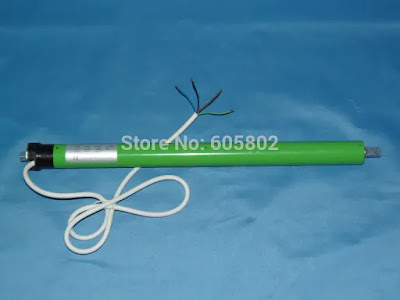Today we mounted the roller blind, I still have some touching up to do on the wall and we plan to install a pelmet made of wood, across the top to hide the whole tube / roll. I'll probably paint this pelmet the same colour as the walls.
Here you can see some photos of the ends of the roller blind.
There is no channel in the tube, inside the tube is all smooth to the touch, so the fabric must be stuck on to the tube, rather than the fabric being inserted in to a channel or groove to secure it.
I recommend you glue the white cap with the pin in to the tube, because when the blind was in operation the white cap wobbled its way out of the tube, as it wasn't a really tight fit.
As we'd already fitted the blind up and didn't want to take it down again and disturb the fixing screws in the wall, we just used a plastic spacer we made and inserted it against the bracket and the white cap to stop the cap wobbling out of the tube, seems to work well now with no issues.
Here you can see the motor end of the blind, the two screws are for the mechanical limits. You get a supplied green plastic tool to adjust these. I connected the motor to the mains power and to the wall switch without connecting the Fibaro shutter module first, so I could set the mechanical limits of the motor for upper top position and for lowest down position.
Test fitting the bracket.
We didn't want to drill up in to the concrete lintel, so instead we mounted the brackets to the sides of the walls inside the window reveal. This meant we had to use plastic blocks behind the bracket to space it out a bit from the wall.
We also moved the box for the module and cable connectors up, so it will be hidden behind the blind / pelmet.
Temporary wiring without the Fibaro shutter module to test the motor and setup the mechanical limits on the motor.
Now wired with the Fibaro shutter module. Hole in the wall where the box was previously located filled in.
Now with the module and cables / connectors pushed back in to the box and the cover screwed on. I used a 47mm deep box and it was only just big enough to fit everything inside of it. The wall still needs fixing with filler and paint.
Roller blind fitted into the window reveal.
The blind can be operated with the wall switch. Before I fitted the Fibaro module you had to press and then hold the switch up or down whilst the blind went up or down. If you let go the motor stopped.
After fitting the Fibaro module and running the calibration routine on the module, now you can just press down and release and the blind comes all the way down. Or you can press up and release and the blind goes all the way back to the top. Whilst the blind is moving if you press up or down again the blind will stop in that position.
We went for a sun screen fabric in grey colour, you can also get full black out fabric from the supplier.
When dark outside the sun screen fabric looks like this. If you want full block you'll need to order the black out fabric.
In the next part I will do a video of the blind in operation and go over some of the software Vera and Imperihome app.
Part 4 here.











































